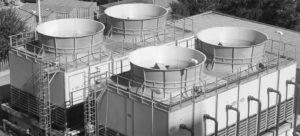Towers vs Radiators, evaporation and air cooling comparison
The use of surface water, underground water or public water supply for industrial processes cooling purposes has been a very common – and reckless – habit until the first half of the 80’s. The increasing environmental awareness, along with problems such as water’s depletion and thermal pollution of surface waters, led to the growing adoption of closed-circuit cooling systems that employ chiller-cooled water.
In order to achieve energy saving benefits, these systems then started using water coming from evaporative towers for the cooling of condensers in chillers. This solution is indeed not causing pollution of surface waters, and is also offering cost reductions compared to air-cooling, which is more expensive and less efficient especially in case of high thermal capacity plants. Compared to air-condensation, evaporative towers allow indeed to achieve an average condensing temperature 10° C lower, which engenders a reduction by 20% in energy consumption.
This is due to the fact that the cooling power of a radiator is strictly related to ambient air temperature, while a cooling tower operates taking advantage of evaporation, therefore in connection with wet bulb temperature.




 Back to index
Back to index Download the complete book
Download the complete book